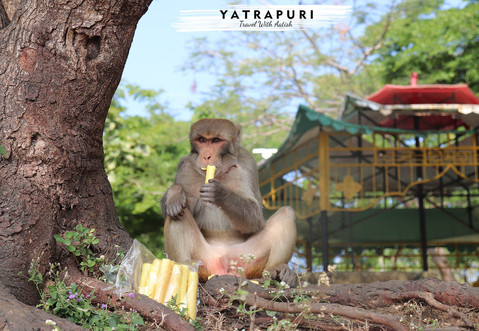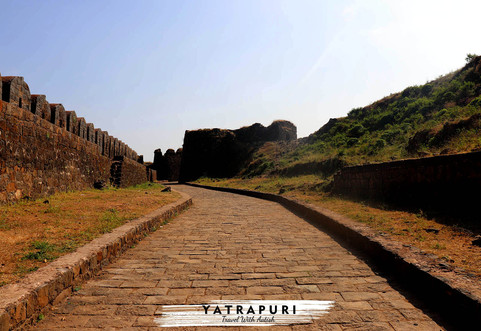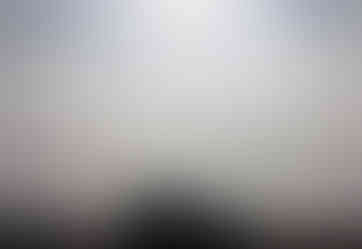Satpura's Retreat – Chikaldhara Hill Station and Melghat Tiger Reserve, Amravati
- Aatish Chavan

- Apr 3, 2020
- 4 min read
Bhimkund, Chikhaldara
Bhimkund is a Natural blue water tank located at a distance of around 78 km from Chhattarpur district, on the way from Chikhaldara to Pratwada.
An old mythological goes that Bhim killed Kichaka and threw him in this valley, giving it the name Kichakdara. He then took a bath in the nearby lake and it is thus called 'Bhimkund'.
Panchol Point, Chikhaldara
This is one of the famous and important points of the area. There is a tar road from the Bir Lake towards this valley from the north side. You can spot coffee plantations on the way while you go towards the point.
This is at 4km from Bir Lake. This is a very deep valley. The five hills edges are connected naturally which has also connected all the valleys and You can hear at least 5 reflected sounds when you give out a voice It is way too prominent here. That's why this point is known as Five Eco Point or commonly called Panchbol Point. Actually, one can hear four return voices, the fifth one is not clearly heard.
Amner Fort, Chikhaldara
It is located beyond village 'Kalamkhar' near village 'Zilpi' about 10 km from 'Dharni' on 'Barhanpur Road'. The Fort is constructed in burnt bricks and is located at the confluence of rivers Tapti, Sipna and Gadga.
The view from the top of the Fort of the confluence from the height of more than 100ft. gives one idea of the magnificence of the fort.
Narnala Fort, Chikhaldara
Resting tall and strong on an unaccompanied hill of the Satpura mountain range, the Narnala Fort stands as a testimony to the Mughals' rich history and their remarkable architecture. This magnanimous fort was one of the thirteen 'sarkars' of Berar Subah and houses intriguingevidences of the majesty of the Mughal Dynasty, including the famous 27-foot cannon- Kadak Bijli. Perched upon a secluded hill at a height of 973 meters, the Narnala Fort offers a panoramic view of the Satpura ranges. Surrounded by a blanket of green and with a backdrop of the bright blue sky, the mesmerising glory of the fort is truly iconic.
This enormous fort is composed of three smaller forts- Zafarabad on the east, Narnala in the middle and Teligarh towards the west. It was originally built by the Gond Dynasty in 10 A.D. and was named after the prestiged Rajput King, Narnal Singh but was taken over by the Mughals in the 15th century. Ever since, it was named Shahnoor Fort and has been the point of interest of many Mughal emperors. Not just that, it was also the birth place of Emperor Aurangzeb's very own great grandson. The renowned Muslim saint, Hazrat Burhanuddin Bagh Sawar Wali, used to set up camp at the fort quite often and claimed to have spotted many white tigers roaming about in the fort!
History of Narnala Fort
Mohammad Ghazni first built the Shahnoor Fort in honour of Bagh Sawar Wali Hazrat Burhanuddin. Because of its unprecedented grandeur and strategically important location, this fort was the point of interest of rulers of many kingdoms who tried to conquer and reconstruct it multiple times. The exact date of construction of Narnala Fory cannot be determined with absolute certainty, but according to a local legend, the first fortifications of the structure were laid by none other than Naryendrapun, a direct descendant of the Pandavas.
The magnificent fort is home to the tomb of Bagh Sawar Wali who was known to ride on white tigers. Hence, they say, a tiny white tiger can be seen walking to his tomb on many nights. There is a small lake inside the fort, and legend says that its waters consist magical healing properties. Anyone suffering from a longstanding disease or illness is said to be cured once they consume the holy waters of this lake. They say that the philosopher's stone or the Paras Patthar lay at the bottom of the lake, a stone that can turn everything it touches to gold. However, when the lake dried up in the famine of 1899-1900, no such stone was found.
Architecture of Narnala Fort
This flamboyant hilltop fortress is made entirely from granite, white and yellow stones. As evidence of unique craftsmanship, all these stones have been bonded together with nothing but the best quality limestone. The fort was originally built by the Rajputs and then taken over by the Mughals. The architectural style of the structure's interiors displays characteristic peculiar to both kingdoms.
On entering the fort, you are greeted with two majestic and architecturally rich gateways- Delhi Darwaza and Sirpur Darwaza. These gates have been designed with the motif of a lotus, and the cornices are inscribed with intricately carved Arabic inscriptions. The lotus motif is called the 'Ashtakamal' or the eight-petal lotus and was the symbol of Raja Narnal Singh's dynasty. One can recognise the Sultanate style of design as soon as you come across the projecting balconies with panels of diverse designs and elaborate stonework that decorate the fort so elegantly.
Inside the fort, there are tombs of King Bagh Sawar Wali and Gaz Badshah, two successful and renowned rulers of their times. Spanning over an area of a whopping 362 acres, the fort houses, 360 watchtowers, 19 tanks, cisterns, an Ambar Bangala or Kacheri and a mosque.
Gwaligarh Fort, Chikhaldara
With 3 gates, an inner and an outer fort, the Gawilgarh Fort is known for its unique architecture. It is one of the three forts in Chikhaldara.
Melghat Tiger project, Chikhaldara
The Melghat Tiger Reserve is found in the northern part of the Amravati District, Maharashtra. it is one of the 9 tiger reserves identified by Project Tiger. It is found on the Gavilgarh Hill, a southern offshoot of the Satpura Hill Ranges of Central India. A hill forest region, the reserve has thick undergrowth and a majority of teak trees. Boasting of 82 tigers and other animals like panthers, sloth bears, sambar, wild bear, and wild dogs, the Melghat Tiger Project has a total area of around 1677 sq. km. One often spots eagles in Melghat.
This region is also a water harvesting forest as it lies in the catchment area of River Tapti. It supplies part of the freshwater used by people in the vicinity.
Entry: Adult - INR 40, Child - INR 15, Jeep/Car - INR 100
Camera Use: INR 200-250
Guide/Safari: INR 300
















































Comments